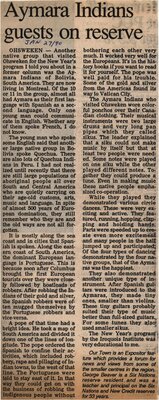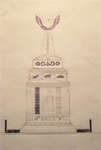"Aymara Indians Guests on Reserve"
- Publication
- Brantford Expositor, Winter 1990
- Full Text
- Aymara Indians guests on reserve
OHSWEKEN - Another native group that visited Ohsweken for the New Year's program I told you about in a former column was the Aymara Indians of Bolivia, South America. They are now living in Montreal. Of the 10 or 11 in the group, almost all had Aymara as their first language with Spanish as a second language. Only one young man could communicate in English. Whether any of them spoke French, I do not know.
The young man who spoke some English said that another large native group in Bolivia spoke Quechua. There are also lots of Quechua Indians in Peru. I had not realized until recently that there are still large populations of aboriginal people all over South and Central America who are quietly carrying on their age-old customs, arts, music and language. In spite of almost 500 years of European domination, they still remember who they are and the old ways are not all forgotten.
It is mostly along the sea coast and in cities that Spanish is spoken. Along the eastern coast of South America, the dominant European language is Portuguese. This is because soon after Columbus brought, the first European tourists over they were closely followed by boatloads of robbers. After robbing the Indians of their gold and silver, the Spanish robbers were often mugged themselves by the Portuguese robbers and vice-versa.
A pope of that time had a bright idea. He took a map of South America and divided it down one of the lines of longitude. The pope ordered the Spanish to confine their activities, which included robbery, rape and pillaging of Indian towns, to the west of that line. The Portuguese were told to stay east of it. In that way they could get on with the business of robbing the indigenous people without bothering each other very much. It worked very well for the Europeans. It's in the history books if you want to read it for yourself. The pope was well paid for his trouble. Some of the gold and silver from the Americas found its way to Vatican City.
The Aymara Indians who visited Ohsweken wore colorful ponchos over their Canadian clothing. Their musical instruments were two large drums and very long pan pipes which they called sikus. The leader explained that a siku could not make music by itself but that at least two people were needed. Some notes were played on one siku while the other played different notes. Together they could produce a tune. Even in making music these native people emphasized co-operation.
While they played they demonstrated various circle dances. These were very exciting and active. They featured, running, hopping, clapping and holding hands. Parts were speeded up to create even more excitement and many people in the half jumped up and participated. Of the four types of dancing demonstrated by the four native group, that of the Aymaras was the happiest.
They also demonstrated another unique type of instrument. After Spanish guitars were introduced to the Aymaras, they made tiny ones, smaller than violins. These tiny guitars probably suited their type of music better than full-sized guitars. For some tunes they also used smaller sikus.
The New Year's program by the Iroquois Institute was very educational to me.
Our Town is an Expositor feature which provides a forum for news and views from some of the smaller centres in the region. George Beaver is a Six Nations reserve resident and was a teacher and principal on the Six Nations and New Credit reserves for 33 years.
- Creator
- Beaver, George, Author
- Media Type
- Newspaper
- Item Types
- Articles
- Clippings
- Description
- "Another native group that visited Ohsweken for the New Year's program I told you about in a former column was the Aymara Indians of Bolivia, South America. They are now living in Montreal. Of the 10 or 11 in the group, almost all had Aymara as their first language with Spanish as a second language. Only one young man could communicate in English. Whether any of them spoke French, I do not know."
- Date of Original
- Winter 1990
- Subject(s)
- Local identifier
- SNPL002738v00d
- Collection
- Scrapbook #1 by Janet Heaslip
- Language of Item
- English
- Creative Commons licence
 [more details]
[more details]- Copyright Statement
- Public domain: Copyright has expired according to Canadian law. No restrictions on use.
- Copyright Date
- 1990
- Copyright Holder
- Brantford Expositor
- Contact
- Six Nations Public LibraryEmail:info@snpl.ca
Website:
Agency street/mail address:1679 Chiefswood Rd
PO Box 149
Ohsweken, ON N0A 1M0
519-445-2954




